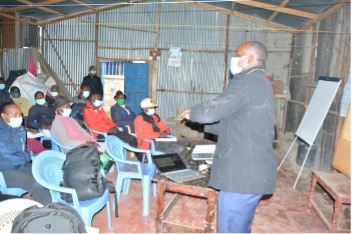ACTS is implementing a project on Multihazard Urban Disaster Risk Transitions that focuses on disaster risk management interventions and capacity building in Nairobi, Kenya.
The project provides options for anchoring actions for climate change adaptation, while also contributing to mitigation against urban disasters associated with climate variability. The Nairobi Risk Hub is part of the larger Urban Disaster Risk Hub (Tomorrow’s Cities). It is a five-year global interdisciplinary research hub funded by UK Research and Innovation (UKRI) Global Challenges Research Fund (GCRF).
The aim of this project is to catalyze a transition from crisis management to multi-hazard risk-informed planning and decision-making, for cities in low-and-middle income. Specifically, the Nairobi Hub seeks to provide Nairobi with the capacity and policy framework that enables a shift from crisis response towards integrated development planning for enhanced disaster risk preparedness and management.
It utilizes interdisciplinary research as a tool to convene stakeholders from across sectors and local communities to facilitate collective action towards addressing the drivers and impacts of multiple hazards. Its programs of work seek to establish a new integrated evidence base on the city’s most prominent hazards and risks, their drivers, uncertainties, root causes and potential solutions, as well as to build greater capacity for collecting and applying this evidence in disaster risk management.
Since it started, the project has covered significant ground in mapping out stakeholders and documenting their perceptions and understanding of risks among the urban poor. This has been achieved through structured dialogue with local community leaders, city policy makers, national policy makers, researchers, institutions of higher learning, opinion leaders, practitioners, civil society organizations and global partners
Community level engagements at community levels focused of poverty, high cost of living exacerbated by COVID-19, insecurity, land access and affordable housing. Local leaders attributed high poverty to perennial floods and fires which tend to occur concurrently due to high exposure (e.g. markets located near rivers) and dynamic vulnerabilities to environmental and physical factors like poor basic infrastructure.

One of the community engagement fora by the Nairobi Risk Hub to understand perceptions and of risks among stakeholders.
Discussions revealed that risk is hardly integrated into even the emergency response activities at the local and city levels. This is mainly due to limited knowledge and resource capacity.
The engagement also unpacked the limited interaction between the urban poor and different disciplines social and physical sciences) and expertise revealing the limited understanding about the context, root causes of the risk and potential remedies among the urban poor. There is also persistent gap among the various stakeholders engaging the local communities in risk reduction.
The process incorporated elements of co-production of knowledge and evidence, facilitating local community led discussion, listening to the local community and their leaders, creating space for dialogue with them and other stakeholders, to cross-fertilize ideas and knowledge, engaging all sectors at the city level and strengthening relations and incorporating them into research activities.
Following the engagements, there has been buy-in from the city policy makers, local communities and stakeholders, which is evident in the ongoing implementation of the impact case; and also enhanced an in-depth understanding of the interactions between the social drivers and multiple physical hazards and their impacts that could provide a good framing for DRR plans for the city and spur a framework for collective action through the evidence-based convening of DRR decisions and actions. Key Nairobi Risk Hub Engagement Activities.
More information about the project can be accessed here

